Likely Geographic Distributional Shifts among Medically Important Tick Species and Tick-Associated Diseases under Climate Change in North America: A Review
- PMID: 33807736
- PMCID: PMC8001278
- DOI: 10.3390/insects12030225
Likely Geographic Distributional Shifts among Medically Important Tick Species and Tick-Associated Diseases under Climate Change in North America: A Review
Abstract
Ticks rank high among arthropod vectors in terms of numbers of infectious agents that they transmit to humans, including Lyme disease, Rocky Mountain spotted fever, Colorado tick fever, human monocytic ehrlichiosis, tularemia, and human granulocytic anaplasmosis. Increasing temperature is suspected to affect tick biting rates and pathogen developmental rates, thereby potentially increasing risk for disease incidence. Tick distributions respond to climate change, but how their geographic ranges will shift in future decades and how those shifts may translate into changes in disease incidence remain unclear. In this study, we have assembled correlative ecological niche models for eight tick species of medical or veterinary importance in North America (Ixodes scapularis, I. pacificus, I. cookei, Dermacentor variabilis, D. andersoni, Amblyomma americanum, A. maculatum, and Rhipicephalus sanguineus), assessing the distributional potential of each under both present and future climatic conditions. Our goal was to assess whether and how species' distributions will likely shift in coming decades in response to climate change. We interpret these patterns in terms of likely implications for tick-associated diseases in North America.
Keywords: Canada; Mexico; United States; current and future scenarios; ecological niche modeling; potential geographic distribution.
Conflict of interest statement
The authors declare that there is no conflict of interest.
Figures

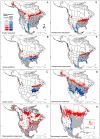


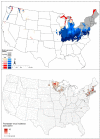
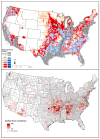
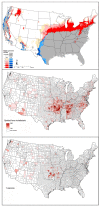
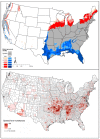
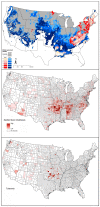
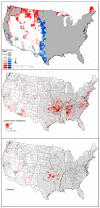
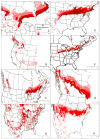
Similar articles
-
Climate change influences on the geographic distributional potential of the spotted fever vectors Amblyomma maculatum and Dermacentor andersoni.PeerJ. 2022 May 3;10:e13279. doi: 10.7717/peerj.13279. eCollection 2022. PeerJ. 2022. PMID: 35529481 Free PMC article.
-
Evidence for increasing densities and geographic ranges of tick species of public health significance other than Ixodes scapularis in Québec, Canada.PLoS One. 2018 Aug 22;13(8):e0201924. doi: 10.1371/journal.pone.0201924. eCollection 2018. PLoS One. 2018. PMID: 30133502 Free PMC article.
-
Establishing a baseline for tick surveillance in Alaska: Tick collection records from 1909-2019.Ticks Tick Borne Dis. 2020 Sep;11(5):101495. doi: 10.1016/j.ttbdis.2020.101495. Epub 2020 Jun 20. Ticks Tick Borne Dis. 2020. PMID: 32723642 Free PMC article.
-
Range Expansion of Tick Disease Vectors in North America: Implications for Spread of Tick-Borne Disease.Int J Environ Res Public Health. 2018 Mar 9;15(3):478. doi: 10.3390/ijerph15030478. Int J Environ Res Public Health. 2018. PMID: 29522469 Free PMC article. Review.
-
A scoping review of applied tick control research in North America: funding, implementation, and advancement.J Med Entomol. 2025 Mar 17;62(2):236-276. doi: 10.1093/jme/tjae155. J Med Entomol. 2025. PMID: 39739609
Cited by
-
Leveraging machine learning approaches for predicting potential Lyme disease cases and incidence rates in the United States using Twitter.BMC Med Inform Decis Mak. 2023 Oct 16;23(1):217. doi: 10.1186/s12911-023-02315-z. BMC Med Inform Decis Mak. 2023. PMID: 37845666 Free PMC article.
-
An analysis of companion animal tick encounters as revealed by photograph-based crowdsourced data.Vet Med Sci. 2021 Nov;7(6):2198-2208. doi: 10.1002/vms3.586. Epub 2021 Aug 20. Vet Med Sci. 2021. PMID: 34414695 Free PMC article.
-
Climate Crises and Developing Vector-Borne Diseases: A Narrative Review.Iran J Public Health. 2022 Dec;51(12):2664-2673. doi: 10.18502/ijph.v51i12.11457. Iran J Public Health. 2022. PMID: 36742229 Free PMC article. Review.
-
Tick-Borne Disease Prevention Behaviors Among Participants in a Tick Surveillance System Compared with a Sample Of Master Gardeners.J Community Health. 2022 Apr;47(2):246-256. doi: 10.1007/s10900-021-01041-9. Epub 2021 Nov 2. J Community Health. 2022. PMID: 34727297
-
Passive collection of ticks in New Hampshire reveals species-specific patterns of distribution and activity.J Med Entomol. 2023 May 12;60(3):575-589. doi: 10.1093/jme/tjad030. J Med Entomol. 2023. PMID: 37030013 Free PMC article.
References
-
- Sonenshine D.E., Roe R.M. Biology of Ticks. Volume 2 Oxford University Press; Oxford, UK: 2013.
-
- Bowman A.S., Nuttall P.A. Ticks: Biology, Disease and Control. Cambridge University Press; Cambridge, UK: 2008.
-
- Climate Central 2019 Wrapped Up the Warmest Decade on Record. Climate Central. [(accessed on 15 August 2020)];2020 Available online: https://www.climatecentral.org/gallery/graphics/2019-wrapped-up-the-warm....
-
- Bush E., Lemmen D.S. Canada’s Changing Climate Report. Government of Canada; Ottawa, ON, Canada: 2019.
Publication types
Grants and funding
LinkOut - more resources
Full Text Sources
Other Literature Sources

